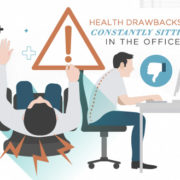The Makings of a Healthy Office
A lot has been said about the importance of a workplace that cares for the well-being and health of its employees. Moreover, there’s an increasing number of overworked employees from today’s workforce, each one demanding for a better working environment and a healthy office.
Several reports from last year have said that workplace burnout have reached epidemic proportions. On a survey conducted among 614 US human resource professionals, 95% of HR leaders said that burnout is ruining workplace retention. When asked on the main contributors to burnout, respondents said that unfair compensation (41 percent), unreasonable workload (32 percent) and too much overtime (32 percent) ranked the highest.
The millennial generation have also made it clear that they want companies to be more attentive of their health. Experts have said that companies need to develop workplace wellness programs in order to attract more talents from the younger generation.
Due to the complexity of workplace culture and company policies, it became very hard for one to know whether or not his/her workplace is a healthy office.
HR.BLR defined workplace wellness as workplace health promotion activity or organizational policy in support of healthy behavior in the workplace and improve health of the employees. Companies can either incorporate medical screenings, on-site fitness programs or allot time for exercise sessions.
Dr. Carmella Sebastian of the WELCOA (Wellness Council of America) says that though it’s hard to quantify, a company’s investment on the well-being of its workforce can increase their morale, loyalty and engagement – all of which are good for both parties. She also adds that as the generation of Millennials start pouring in to talent pools, proactively engaging them is deemed to be a smart move.
But before anything else, there are certain things a company should take into consideration in developing its very own workplace wellness program.
Making It Healthier
Before implementing any changes or new regulations, it is only right to assess what you’re up against.
Taking into consideration that healthcare and associated costs can differ from company to company and from one industry to another, organizations need to know their population. Among your employees, how many of them are active smokers? And who among them are desk-bound?
Assessing the health of your employees through medical examinations can give your real time information on your population. In addition to this, it’s also important to know what activities and health topics they will be interested in. Create surveys and analyze what they would like to in terms of improving their health.
After gathering all the data needed to get a picture of what your company’s wellness is like, challenges will arise. For example, majority of your workforce are chronic smokers and the rate of bronchitis as well as lung cancer within your organization have gone above average.
Go for the low-hanging fruit and start turning your organization into a smoke free enterprise. Start executing policies that prohibits smoking in front of the building or anywhere near its proximity. By doing this, you are decreasing your workforce’s smoking rate by 6 percent and can result to people quitting.
Dr. Carmella Sebastian says that companies need to win their employees over and make it known that their health and overall well-being matters to the whole organization. Incentivize their efforts for participating and make them see that it matters to the company that they take good care of themselves.
And as your program flows through, celebrate your successes. Share with them the setbacks and challenges they conquered and the goal they have reached. Through this, you are increasing their morale.
A Healthy Office
Private companies aren’t the only one’s taking care of the health of today’s workforce. Serviced offices like call center seat leasing, private offices, and outsourcing spaces are taking into consideration the impact the workplace has on a person’s wellness. From spearheading events such as health fairs to designing their facilities to be healthier – installing bright lighting and ergonomic chairs and desks – providers are making sure that their members’ health are prioritized.
The discussion is yet to be over and there’s still more to cover. Day by day, our idea on how we work are changing and though these changes are deemed unorthodox, all of them are necessary for us to be better in our respective fields.
Change for the better and see what a healthy office looks like.












Leave a Reply
Want to join the discussion?Feel free to contribute!